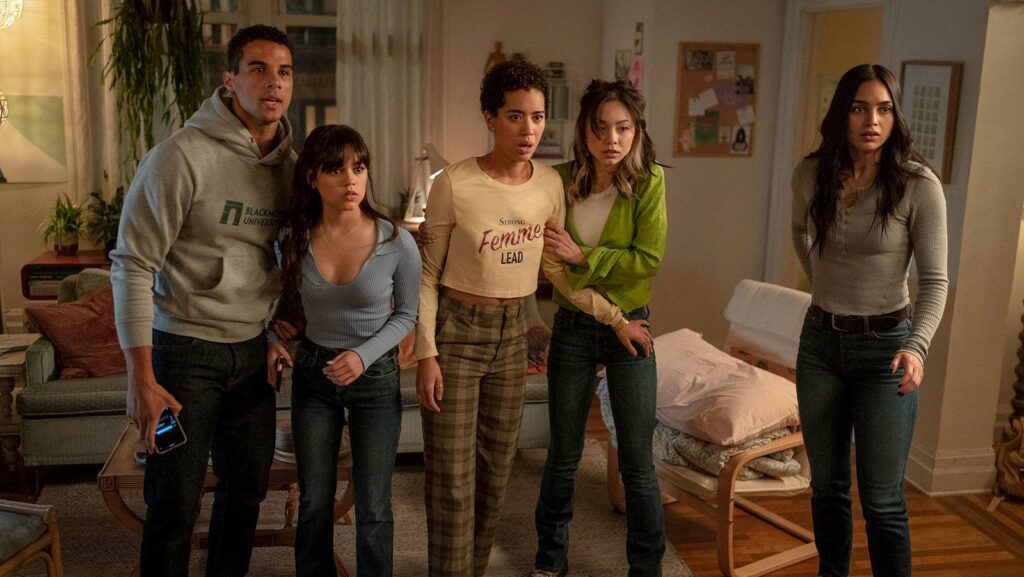
Between the Oscars, our TV rankings, and our list of the year’s best movies, it’s been a busy past month here at MovieManifesto. As a result, while I was able to write a few proper reviews of new movies (the new Shyamalan, the new Ant-Man), I neglected to make time for a bunch of additional 2023 films. That changes now! Well, sort of. Unlike Lydia Tár, I can’t stop time, so I’m unable to carve out enough space for full reviews. Instead, we’re firing off some quick-and-dirty capsules, checking in on five recent releases. Let’s get to it.
Scream VI. The clever double-act of the Scream pictures—the platonic ideal established by the first installment and never quite equaled since—is that they’re movies about scary movies and are also, well, scary movies. In the prior episode, Scream (which should have been called Scream 5, but never mind), new directors Matt Bettinelli-Olpin and Tyler Gillett satisfied one and only one side of that equation, cleverly skewering the toxic fandom that attends modern discourse but failing to serve up memorable carnage. Now returning with Scream VI, the pair have essentially flipped the script. The meta ideas bandied about here are a little less trenchant, but the nuts-and-bolts execution—and executions—is first-class.
This isn’t to say that Scream VI skimps on its obligatory semiotics. Per usual, there’s a scene in which a cinephile (Jasmin Savoy Brown) educates her fellow characters—some of whom are destined to be bloody victims, others who just might be psychotic killers (that each Scream typically features multiple murderers makes armchair-sleuthing all but impossible, as purported alibis prove meaningless)—about the “rules” of the pertinent subgenre. Here, the ostensible target is the soulless march of corporate franchises, but while the script (again written by James Vanderbilt and Guy Busick) lands a few body blows aimed at mercenary studios—the remark that no actor or character is more important than the broader intellectual property is surely echoing in the halls of Disney and the MCU—the insights are obvious and timid. It doesn’t help that the movie itself proves weirdly soft, preferring miraculous recoveries and precious continuity over permanent death.

Still, there are plenty of actual kills in Scream VI, and they’re mostly glorious. In the year between sequels, Bettinelli-Olpin and Gillett have leveled up their craft, delivering set pieces that are smartly designed and skillfully choreographed. The double-cold open—which begins with a hopelessly naïve professor (Samara Weaving, decked out in a striking canary-yellow dress) wandering into a dark alley for some shadowy evisceration, then follows an unmasked(!) Ghostface home for a second course of stabbing—is a smashing introduction, fusing inevitability with surprise. Later, a nightmarish scene at a bodega is agonizingly quiet, as two terrified sisters (Melissa Barrera and Jenna Ortega, both sturdy in their second go-round under the knife) attempt to outmaneuver Ghostface in a deadly game of cat-and-mouse. And midway through the film, Bettinelli-Olpin and Gillett serve up one of the best sequences in the entire franchise: a chilling escape involving a rickety ladder, a prolonged crawl, and an even longer fall.
“Who gives a fuck about movies!” Ghostface snarls while dispatching a feeble copycat. It’s a question that’s rhetorical, coy, and a little tedious, given Scream VI’s perfunctory approach to cinematic analysis. Yet even if you roll your eyes at times, you will find it hard not to smile when the movie introduces you to a lair festooned with costumes, weapons, and other pieces of iconography from prior entries in the franchise. At this point, the Scream movies are less about the horror genre at large than about themselves. They’re an institution, and if Scream VI is just another book in its library, at least it often reads like a sacred text. Grade: B-

Cocaine Bear. As B-movie premises go, “What if a bear did cocaine?” is a pretty good one. And there are moments in Cocaine Bear, the goofball action comedy directed by Elizabeth Banks from a script by Jimmy Warden, that threaten to approach the giddy zaniness of its conceit. In particular, the misadventures of a pair of medics (Kahyun Kim and Scott Seiss)—involving a door, an ambulance, and a frenzied computer-generated mammal—locate the right balance between silliness and suspense.
The problem with Cocaine Bear is that it doesn’t feature enough such scenes of genuine invention to distract from its broader story, which is absolutely infantile. There’s an argument that the film is aware of its own stupidity, and that to nitpick its pointless plot or its thin characters is to miss the playful forest for the scrawny trees. I might buy that if the dialogue were funnier or the violence were sharper, but the film is weirdly inert on the level of both action and comedy. No movie starring Keri Russell in a pink tracksuit is irredeemable, and in a few sequences—as when the titular animal suddenly collapses from exhaustion, trapping a helpless human underneath it—Cocaine Bear lives up to its demented promise. For the most part, though, the bear’s behavior in that scene proves oddly inspirational, encouraging you to follow suit and take a nap. Grade: C

Creed III. Near the end of Scott Pilgrim vs. the World, Michael Cera’s title character, having previously vanquished seven different challengers in combat, must face the ultimate foe: a greyed-out version of himself called Nega Scott. In bold strokes, that’s basically the outline for Creed III, but while it may sound silly (Scott and Nega Scott end up setting a date for brunch), the third installment in the Rocky spinoff series is a work of surprising gravity and potency. Its structure may be conventional—the winner of each bout is preordained—but it locates shivers of new energy within its cozy confines.
This isn’t exactly unexpected, given that the prior two Creed pictures—the first directed by Ryan Coogler, the second by Steven Caple Jr.—infused the quasi-moribund Rocky franchise with vital new life. Their greatest asset was the lead performance by Michael B. Jordan, who here slides into the director’s chair and blends steady filmmaking chops with occasional aesthetic flair. He doesn’t over do it, but he flashes some ambition and imagination; during the climactic fight—yes, of course there’s a climactic fight—the crowd suddenly melts away, and the ropes of the ring are replaced by rigid steel bars, briefly turning a test of iron wills into a literal cage match.
That’s an inspired moment, but overall, the actual boxing fights are the least interesting part of Creed III, failing to distinguish themselves from countless other squared-circle sequences that make up one of sports cinema’s most durable subgenres. (The constant commentary from ringside announcers only multiplies the familiarity factor, as does the relentless product placement for Showtime and ESPN.) The screenplay (by Keenan Coogler and Zach Baylin), which begins with Donnie Creed (Jordan) thriving in retirement as a promoter, initially threatens to break into new territory before eventually succumbing to formula, supplying the usual array of frail moms, worried wives (Tessa Thompson is underserved), and training montages.
Yet even if Creed III isn’t especially persuasive as a piece of storytelling, it succeeds as an invigorating study of friendship and masculinity. That’s because the key relationship in the movie is the one between Donnie and Dame, his childhood friend and ex-con played with electric intensity by Jonathan Majors. Dame is in some ways a dark-universe version of Donnie, one who couldn’t be rescued from his angry impulses and poor circumstances. This vision of the road not taken means that Donnie regards his frenemy with a fascinating mixture of sympathy, fear, and guilt, and the dialogue scenes between them—at a grubby diner, at Donnie’s mansion, at a launch party—seethe with tension and uncertainty. Those qualities are amplified by Majors, whose twitchy intelligence and roiling charisma make Dame the franchise’s most complex antagonist. You never feel safe around Dame; you also never take your eyes off him. Grade: B

Magic Mike’s Last Dance. If you’re looking for delayed gratification, try the nightclub down the street. Roughly five minutes into the latest (and last) Magic Mike movie, our erstwhile exotic dancer (Channing Tatum, duh) is disrobing in a swanky Miami estate, treating a wealthy woman named Max (Salma Hayek Pinault) to the private dance of her life. The visuals are striking—as shot by Steven Soderbergh, returning as director (and cinematographer, and editor) after he sat out the deliriously entertaining sequel, the twilight Florida sky emits a seductive midnight-blue glow—but they’re nothing compared to Mike and Max’s moves, as a one-sided transaction quickly transforms into a duet of rhythm, fluidity, and desire. It’s exhilarating.
Unfortunately, the rest of Magic Mike’s Last Dance is rather less stimulating. If the first film was a penetrating study of body commodification in the gig economy and the second was a blissed-out celebration of athletic male grace, round three is a little less enjoyable and a lot less insightful. The plot, bizarrely enough, resembles Footloose: Max recruits Mike to come to London and reenvision a staid, Austen-esque costume drama (called Isabel Ascendant) as a rip-roaring strip show, only to be opposed by, er, powerful interests. Thematically speaking, it’s a lazy and unconvincing indictment of classical art as sexist and stiff; it’s the kind of movie where a vengeful husband attempts to shut down his wife’s theater, just to be petty. It’s similarly unsuccessful as a romance; as much physical chemistry as Tatum and Hayek Pinault evince in that opening sequence, their characters are too thinly written for their love story to take flight.
This is a bummer, but it doesn’t fully torpedo Magic Mike’s Last Dance, which works reasonably well as a collection of gyrating set pieces. There’s an interlude where the movie transitions, almost magically, into an Ocean’s-style caper, with Soderbergh applying his gifts for pacing and editing to a flash mob on a bus. And the finale, in which Tatum and a ballerina (Kylie Shea) exchange performative glances while sliding across a water-drenched stage, is a masterful display of choreography. Ultimately, the movie ends up inadvertently resembling Isabel Ascendant: It’s pretty to look at, so long as you don’t interrogate its ideas. Grade: C+

Emily. There is a risk of describing Emily, the directorial debut of Frances O’Connor (best known for playing Haley Joel Osment’s mother in A.I.) about the second-youngest Brontë sister, along the lines of a traditional costume drama—yet another biopic of artistic genius and woe set in the English countryside. As it happens, this is exactly the kind of movie I tend to like, and I appreciate Emily for its delicate finery: its neatly embroidered frocks and bonnets, its rolling hills and stately manors, its collision between buttoned-up propriety and heaving passion.
But there’s more to it than that. Or maybe it’s exactly that, only more so. Either way, Emily is a film of deep and real feeling, one whose placid demeanor belies its brewing storm clouds. The same might be said of Emily herself; as played by Emma Mackey (Sex Education), she’s a demure and accomplished young woman whose carefully laced corsets struggle to restrain a volcanic disposition and restless imagination, both of which she eventually channels into the pages of Wuthering Heights. (When her sister Charlotte describes the novel as “an ugly book full of ugly people,” Emily simply responds, “Good.”)
The plot of Emily, which wisely homes in on a narrow period in its heroine’s too-short life, explores a handful of her fraught relationships, the most central of which involves an impossibly handsome curate (Oliver Jackson-Cohen, from The Haunting of Hill House). Together they create a heat that isn’t quite as sizzling as it’s meant to be; this is partly by design, but also because Jackson-Cohen’s affected smolder is no match for Mackey’s innate magnetism. The more meaningful pairings here are familial; Charlotte (Alexandra Dowling) is an intriguing foil who toggles between ally and rival, while Emily’s brother, Branwell (Dunkirk’s Fionn Whitehead), is an avatar of insouciant charm who also suffers some of her harshest fury. (The scene in which the more talented Emily coldly dismisses her brother’s writing as childish is a breathtaking display of intelligence, anger, and spite.)
At one point in Emily, the Brontës play a parlor game, passing around a mask and impersonating famous figures; it’s a light, frivolous moment—at least until Emily dons the shroud and conjures a deceased relative, terrorizing her kin with the certitude of her portrayal. As masked scenes go, it’s as riveting as any sequence from Scream VI, and it speaks to the movie’s surprising grit. It’s a gorgeous costume drama that also exhibits a willingness to get dirty, even as it soars to those literary heights. Grade: B+
Jeremy Beck is the editor-in-chief of MovieManifesto. He watches more movies and television than he probably should.
